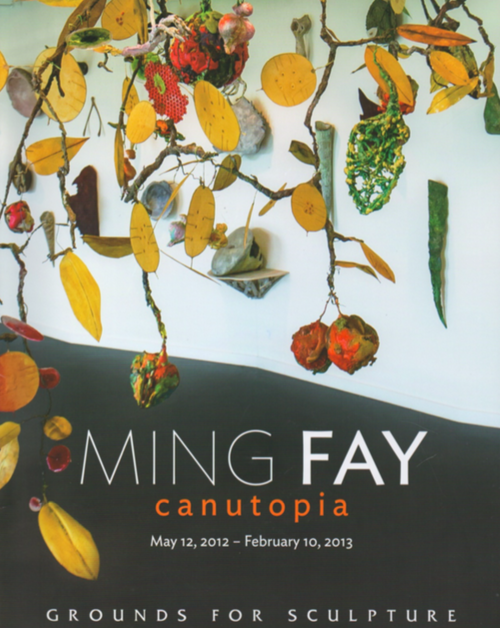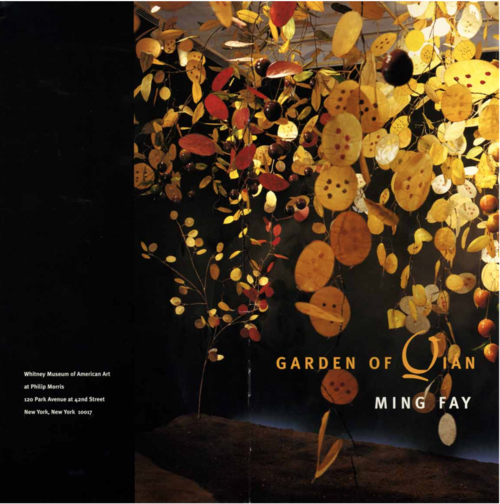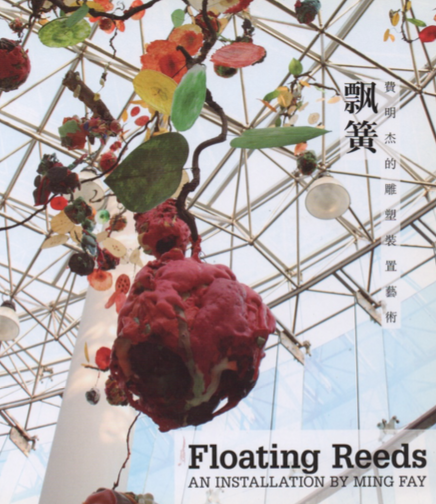Essays
Many of the following exhibition catalogues and essays were originally published in print and are available to view in their original format in full by clicking the button "Read More".
Garden of Qian
| Essays by Eugenie Tsai and John Yau
“Ming Fay’s Garden of Qián prompts flights of fantasy in the viewer, flights to realms far removed from the urban jungle… Intertwining fruit and foliage hang above a bed of soil embedded with gleaming pennines. While the vegetation looks familiar to us, close examination reveals that nothing can be identified with certainty—this is no ordinary garden . . .” -Eugenie Tsai
“Is Ming Fay’s Garden of Qián an installation, a sculpture, or a still life? Or does it challenge all these categories? And in doing so, does it compel us to reconsider what relationship art has to our lives? . . .”- John Yau
Ming Fay: From Money Trees to Monkey Pots
| Essay by Jonathan Goodman
“A veteran of the New York art scene, sculptor Ming Fay remembers the city forty years ago, when its urban ways were raw and rough, and even more financially troubled than today. Even so, the environment of the city at the time was favorable to sculptors who took over the big semi-industrial spaces of Soho and eked out lives entirely devoted to the production of art . . .”
Ming Fay Canutopia
| Essay by Virginia Oberlin Steel
"Over the course of Ming Fay's long and impressive artistic career, the primary inspiration for his work has been the relationship between mankind and nature. Canutopia - a retrospective of sorts - is composed of sculptures Fay has created during the past 30 years. The personal and artistic path he forged that has led him to create this major installation is a clear testament to the deeply held values that connect all of Fay's work. Complex both metaphorically and visually, Canutopia is a feast for the eyes, mind, and the spirit . . ."
Ming Fay: Nature, Symbol, and Myth Inspire Public Art | Essay by Barbara E. Martin
“Nature and light are twin themes in the work of sculptor Ming Fay… He is increasingly involved in public art projects around the country in which he is continually re-inspired by nature to create art that uses some element of the natural world to illuminate an idea which is grounded in fantasy or mythology. “I am more interested in symbolic meaning,” Fay explains, “I am always inventing, searching, and playing in an imaginative way. I’m a hybrid—I’m a scientist who creates or closes an object, and then finds meaning in it. . .”
Ming Fay: Money Trees & Monkey Pots an Installation of Montalvo Specimens
| Essay by Michele Rowe-Shields
“New York based Chinese artist Ming Fay creates fantastic gardens with gargantuan vegetation— cherries as big as coconuts, silver dollars the size of dinner plates, and monkey pots as large as watermelons. Like a fanciful naturalist or horticulturalist, Fay’s rare species are based on actual plant forms but presented in ways that make them seem exotic and unfamiliar. The artist combines Eastern and Western philosophies and vegetation to pose questions about our complex and often ambiguous relationship with nature . . .”
Floating Reeds: An Installation By Ming Fay
| Essays by Victoria Lu & Martina Köppel-Yang
“Ming Fay is not only a mature artist but also a talented magician of visual masterpieces. He brings us to a magical land fall of imagination, a mysterious world that is both real and a surreal universe that his heart belongs to. With his passion and devotion to art, his persistent hard work abroad and his life-long pursuit of his ideas, Ming Fay has set an important example for the generation of artists who grow u in a more favorable environment . . .” - Victoria Lu
“Floating Reeds is indeed about movement, resonance, energy, spirit and nature. The artist developed and invented the organic shapes in his “laboratory garden” as he calls his studio… The artificial object is not a copy of nature, it rather is an invention according to nature, parallel to nature, and thus obtains natural energy and spirit… The margin between natural and artificial, the real and the imaginary, is blurred . . .”- Martina Köppel-Yang
Ramapo Garden of Desire
| Essays by David Shapiro & Eugenie Tsai
"After knowing Ming Fay for two decades, I am still amazed and more than amused when I enter his house on Broadway and am struck by a cornucopia of images: hanging sculptures, wild cherries, vegetables on command, fruit out of control, and a wealth, truly a wealth, of gardens. After all the years I have seen his students imitating his voice, his voice is soft and clear. His work begins with a reference to the real, and somehow he has become the master of a scientific surrealism . . ." - David Shapiro
"Composed of a dense growth of flora in searing tones of fuchsia, orange, and green, Ming Fay's installation, "Ramapo Garden of Desire" transforms the pristine white cube of the Kresge Gallery into a wild corner of nature. Fay's earlier gardens have simulated an archaeological past or envisioned a science-fiction future . . ." - Eugenie Tsai
Ming Fay
| Essay by Barry Schwabsky
"How many "realist" artists there are. But how few pose the question of "realism." The sculptures Ming Fay makes are intimately detailed yet forcefully integral presences. Among the things they are not concerned with: nostalgia, allegory, trompe-l'oeil, funk, narrative. Their subjects are ordinary things . . . "
"Ming Fay"
| Essay by Barry Schwabsky
"Ming Fay's early work was minimalist sculpture - cooly geometrical forms executed in industrial materials. What leap of imagination led him from the Platonic regularity of teh sphere to the variegated imperfection of the pear, from machine-tooled metal to a medium so preeminently hands-on as papier mache? The jump is not so long as it may appear. Ming Fay has not so much lost interested in what were known in the sixties as "primary structures" . . ."
BIBLIOGRAPHY
Duvergne, Tania. "Ming Fay-- From Concept to Reality: Mosaics for the Delancy St / Essex St Subway Station." Artists Alliance, 2004. Web. 25 January 2012.
Chang, Alexandra. "Epoxy Art Group." Grove Encyclopedia of American Art 1. Ed. Joan Marter. New York NY: Oxford University Press, 2011: 165-166. Print.
Heartney, Elanor. Art in Architecture: Selected Works. Washington DC: US General Services Administration, 2008.
Tanguy, Sarah. “Food Matters.” Katonah Museum of Art, NY. 2003.
Stein, Donna. “From Rags to Riches: 25 Years of Paper Art From Dieu Donne Papermill,” 2001.
Hanzal, Carla. “All Terrain,” Contemporary Art Center of Virginia, Virginia Beach, VA, 2001.
McGregor, Jennifer. “Abundant Invention,” Wave Hill, Bronx, NY, 2000
Valerio, William. “Ming Fay.” Queens Museum of Art at Bulova Corporate Center. Queens, NY, 1997.
Morgan, Robert. “Matter into Spirit,” Kim Foster Gallery, New York, NY, 1994.
Hirsch, Faye. “Ming Fay: A feast for the Eyes.” Kohler Arts Center, Sheboygan WI, 1996.
Wong, Wucius. “Mutations of Ink and Paper.” Taipei Gallery, New York, NY, 1996.
Jones, Karen. “Environmentally Concerned,” Nathan Cummings Foundation, NYC, 2000.
Raven, Arlene. “Hidden Seed Garden,” Alison Fine Art, Honk Kong, 2002.
Machida, Margo. "Migration, Mixing, and Place." Unsettled Visions: Contemporary Asian American Artists and the Social Imagery, Duke University Press, 2008: 194-269. Print.
Hallmark, Kara Kelley. "Ming Fay." Encyclopedia of Asian American Artists. Greenwood Publishing Group, 2007: 51-53. Print.
Machida, Margo. "Cultural Conceptualism and the Art of Ming Fay." Transcultural New Jersey: Diverse Artists Shaping Culture and Communities, 2. Office for Intercultural Initiatives and Zimmerli Art Museum, Rutgers, The State University of New Jersey, 2005. Print.
Goodman, Jonathan. "A Decorative Reading of Nature: Ming Fay." Sculpture 22-7, September 2003: 46-51. Print.
Ault, Julie. Alternative Art New York, 1965-1985. University of Minnesota Press / The Drawing Center, New York, NY, 2003: 31, 44, 65. Print.
Barrie, Brooke. Contemporary Outdoor Sculpture. Gloucester MA: Rockport Publishers, 1999: 46-49. Print.
Lippard, Lucy R. Mixed Blessings: New Art in a Multicultural America.Pantheon Books 1990. Print.












